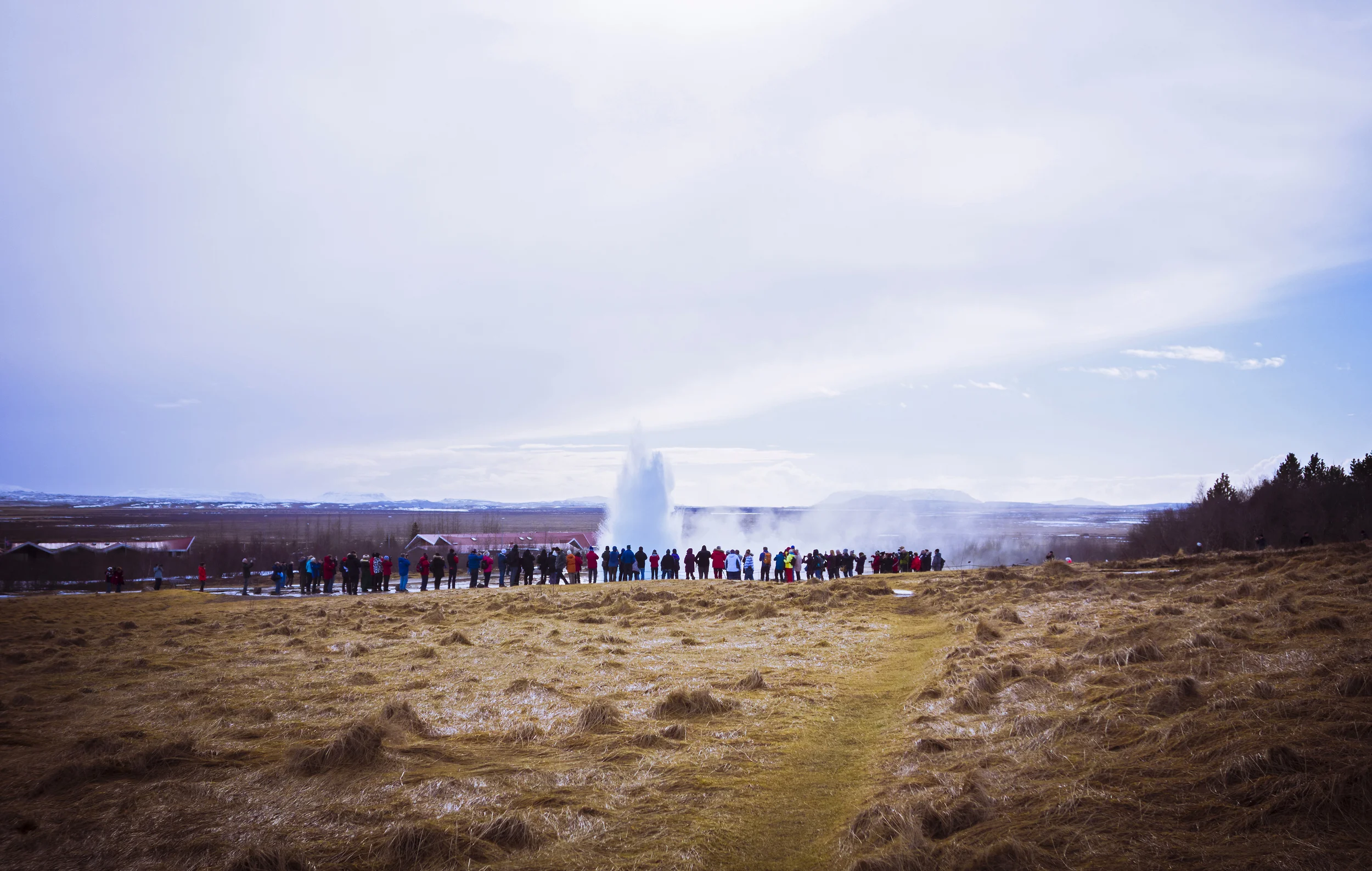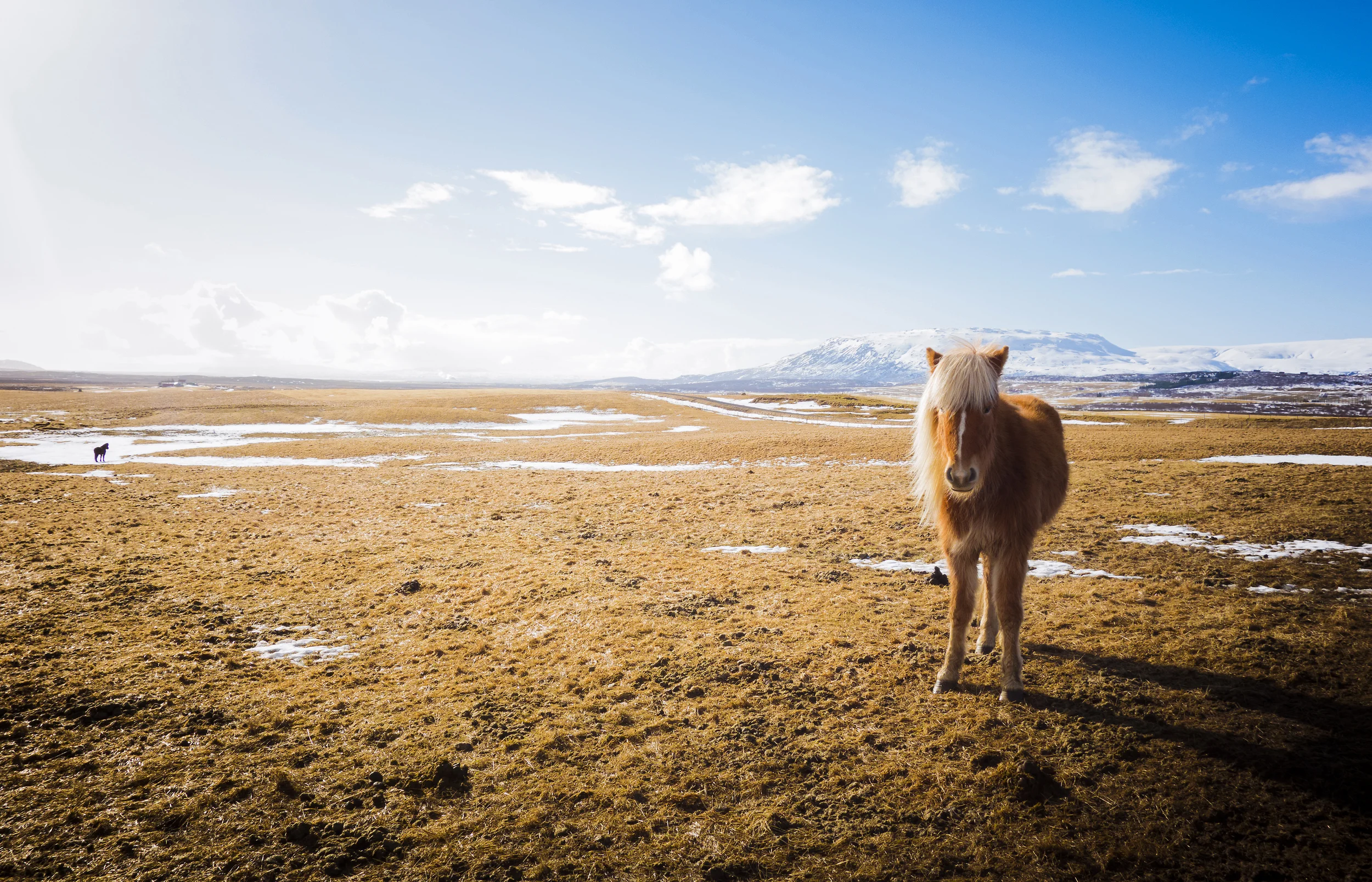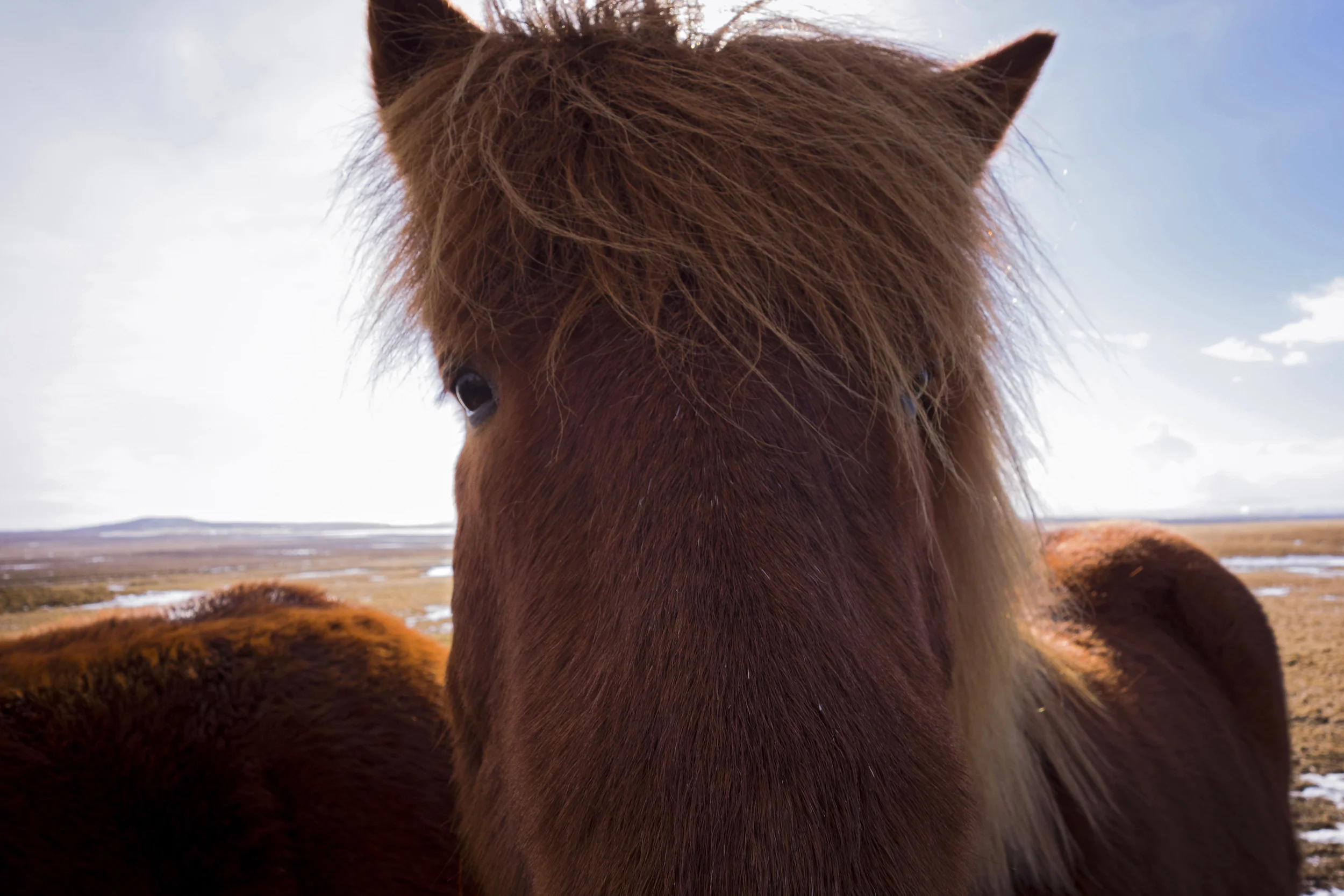The next day, we load the car in the deep blue dark of the early morning. The day, as scheduled, was already going to be a long one - a westward drive out of the southern coastal plains and around the famous Golden Circle - a loop encompassing the most famous sights of the capital region. Our destination and home for the next two nights will be the capital city of Reykjavík. Tonight, the skies over the city will be clear, and electromagnetic energy generated by the confluence of the Earth's magnetism and the Sun's ionic radiation will peak in the upper atmosphere around 10 PM. I have already picked out a prime viewing spot on the coast - all we have to do is arrive safe and awake. We encounter difficulties at the self-serve gas station in Vik, but calculate that we have enough fuel to make it out of the southland. So we are off.
We soon turn off on a southerly road leading to the top of the headland west of Vik. The promontory, Dyrhólaey ("hill with a doorway") features a magnificent sea arch that was visible two days ago from the beach at Reynisfjara, and a lighthouse where we hope to see sunrise and sweeping views of the black sands below. But we quickly discover that we are foiled; Jane stops the car, befuddled. The highway, quite sardonically, descends literally into the bay before emerging a quarter mile away, rising toward toward the bluffs. I can see bright orange traffic cones dotting the flooded stretch - some standing neck-deep in sea water, some floating off into the ocean. The previous storm has taken its toll; grateful that we were not on the peninsula two days ago, we decide not to drive our rental car into the Atlantic Ocean.
Our next stop is the abandoned farm turn-off at Sólheimasandur, the desolate black wasteland that forms the outwash zone of the glacier Sólheimajökull. We pull onto the gravel path again, and park at the makeshift lot beside the highway. From where we sit, the road looks much better than Sunday in the downpour, but there is no telling how we will fare once we get among the sand dunes. On GPS, the line distance to the wrecked Navy plane is less than two miles - an out-and-back trip of no more than two hours. Time is not an issue - it is not even 7 AM, a silver lining of skipping sunrise on the headland. We weigh the relative risks of getting our car stuck out in the wasteland, or getting ourselves stuck in poor weather; it is quickly obvious that we both trust our feet more than the road, and so, jamming our ponchos into our hiking pack, we set off across the field.
What follows is the most haunting, most memorable two hours of our time in Iceland. In practice, walking down a flat stretch of black gravel and sand is not so different from walking down a city block. We follow the car path - it is even generously delineated by the ubiquitous yellow road markers found on every other roadway in Iceland - chatting as we go. But soon we turn silent. Jane pushes ahead while I walk, sometimes sideways, sometimes facing backward. The landscape pushes away from us, until we are truly engulfed by the mountains to our north, the ocean to our south, the endless black wasteland all around. I stand still, and all is quiet except for the beating of ocean surf, several miles away, and the occasional howl of wind from across the desert. From our gravel path, water is less obviously present in this sandur than in the one we saw yesterday, but I know that the flat black plains and the carved, rolling dunes could not exist here by mistake. I think of a torrential glacial flood pouring over this topography, and I resume walking, my pacer quicker than before.
The track bends and rises over a dune, and suddenly we are in view of the plane wreckage, about two hundred yards away. Jane runs down to the derelict vessel, and I follow with my tripod out. As the camera records, we climb into the cabin, over the battered metal plating and under frayed panels and wires. Jane nudges her way into the cockpit, where the forward roof has partially collapsed, and the pilot's seat gazes north toward the mountains, as it has for nearly fifty years. I poke my head out of a cabin window and look left and right, finding the view to be quite charming. Several hundred yards from the tail of the plane, past the last sweep of sand dunes, I can see Atlantic waves crashing upon a beach. In every other direction - black sands, solitary hills, and snow-covered mountains. It is as if we are voyagers who have crash-landed on a distant planet; we are totally alone in this land of volcanic earth and snow. Jane, in a trance, wanders off across the dunes. I photograph her before following.
Walking back toward the highway, I feel a cold droplet on my lip. A single snowflake. We can see the sky in all directions, and we figure, from the clouds we see and the wind we feel, that inclement weather will be blowing in from our west within half an hour. The land is so flat that we can see Baby from a mile away, a tiny gray speck wedged between a line of asphalt and the old farm field. We cut across the sand and through the field, breaking into a jog as we near the car. We climb on board just as snow begins to fall.
On our way out of the southland (I am driving as Jane munches on leftovers from last night's dinner), we stop by an open field where a horse herd is grazing. I tiptoe toward them and watch as they eat, their hairy manes flecked with snow. The snow falls harder as we drive past the familiar faces of Skógafoss and Seljalandsfoss. "Goodbye Skógafoss,"says Jane wistfully as we pass it on the highway. Half an hour later, in the town of Hella, I wake Jane up and we re-fuel at the gas station. Across the street, I photograph her making faces at me in front of three bright, primary-colored houses. We head into the convenience store and buy more sandwiches, a box of cookies, more skyr, a big bottle of juice, and a bag of hard fruit candy. My job is to feed candies to Jane whenever she drives for the rest of the trip.
We depart Hella, but instead of continuing west toward Selfoss and Reykjavík, we take a northward turn toward the Golden Circle. As we move away from the ocean and further north, the road becomes snowier; we wind our way through valleys and mountain passes, little one-lane bridges and small farmyards. More horses stare at us from the roadside. At length, we reach the northern tip of the Circle, and pull into the ice-covered parking lot above Gullfoss ("Golden Falls"), one of the mightiest and perhaps the most visited waterfall in the country. We slot Baby in beside two tour buses.
Even snowbound, Gullfoss is flush with visitors. We rummage through the lopapeysas (Icelandic wool sweaters) on sale in the visitor center, touching the soft fleece and fiber with both hands. Outside, the boardwalk is glazed with ice, and we skate along it to the edge of the canyon and down a flight of metal steps. Below us, the Hvítá River rushes over the frozen land, dropping over two stages into a deep chasm. We lean and peer over the canyon edge as much as we dare - the ground is slippery and unstable - but we cannot see the bottom. The river roars and plunges out of sight, as if disappearing into the center of the earth. There is a steep sloped path that leads down the canyon wall to a lower lookout, but it is treacherous and impassible, covered in a sheet of solid ice. All around us, the land is white and the air biting; we are no longer in the south.
We pull out of the frozen parking lot and drive five minutes west to our next destination, the geothermal park that is home to the world's original Geysir and many of its cousins. Sadly, Geysir, after nearly 10,000 years of activity, has become obstinate and shy as of late, clogged with silica and perturbed by alterations to the local water table over the decades. In recent years, it has hardly erupted at all. Its neighbor, Strokkur ("churn") is a social butterfly by comparison. As a crowd of us, in our multi-colored winter parkas and coats, gather to watch, Strokkur joyously spews forth a mighty jet of steam and water; the fountain shoots up over a hundred feet skyward before raining down upon us in a lukewarm mist. It does this again and again, at intervals of no more than five minutes, while the adoring crowd claps and laughs, encouraging this display of geothermal showmanship. We walk around the dirt path and gaze into orange, yellow, and green mud pools bubbling like cauldrons of rich, earthy stew. Jane has particular affection for Litli Geysir ("little geyser"), a veritable bathtub of water that bubbles and spurts with great determination, producing tiny pops of water no more than a few inches high.
In the car, Jane drinks a coffee and I switch out my camera battery. We drive southwest now, down the highway toward Þingvellir National Park (anglicized: Thingvellir). By the side of the road, we stop at a large field where a family of horses is grazing. The afternoon sun is shining brightly now, lighting the horses' rich brown manes in a sheen of golden light as they stand in their field of winter grass and snowmelt. We walk up and offer our hands cautiously; these impetuous horses, residents along Iceland's most popular tourist circuit, come forward excitedly at the sight of potential strangers bearing gifts. They search our pockets, nibble at Jane's coat sleeve, and snap at each other jealously. "Look at you!" Jane says chastizingly to a black mare. "Is this proper horse behavior?" The mare is undeterred.
We reach Þingvellir ("Valley of the Thing") around 3 PM, and Jane refills her coffee at the visitor center while I gaze out over the landscape, a vast valley coated in snow. To the south, past a massive natural lake (Þingvallavatn), I can see where the land sharpens into a broad range of mountains, a high plateau from which plumes of steam rise into the sky. This was the mountain pass we drove across on the morning of our arrival, and I see more vividly now the vast size and scope of Iceland's geothermal energy. Nearer to me, circling and disappearing into the north shore of the lake, is a cleft in the earth, in some places wide and shallow, and in others forbodingly deep and narrow. We are standing atop a rift valley, a place where tectonic slabs of the earth's crust slide and separate. The plates that adjoin each other here - and indeed, across all of Iceland, which owes its very existence to this fact - are the North American and Eurasian plates. These plates diverge from each other at the Mid-Atlantic Ridge, creating the ocean-spanning, mightily volcanic vent in the planet through which Iceland was born. Jane joins me with her coffee, and we reflect on that fact that we two oceanography enthusiasts are standing together on top of the Mid-Atlantic Ridge. The Icelandic settlers of yore must have also felt the gravity of this place; the valley was the original home of the Alþingi ("All-thing") or Icelandic Parliament, and stood as the island's central seat of government for centuries. We walk along the top of the valley and follow the well-laid boardwalk down into a dramatic part of the canyon; we climb up one side of the igneous formation and find a space to sit, gazing out at the formidable vista for some time. The majesty of plate tectonic theory.
Back in the car, we are done with the Golden Circle, setting our coordinates for Reykjavík. It is 4 PM, and our plan is to navigate to a grocery store, avail ourselves of a stay-at-home feast in our new guesthouse, and nap for several hours before the Sun and Earth begin their electromagnetic dance party. We drive southwest from Þingvellir over the frozen tundra, passing through several minute-long hailstorms along the way. Jane is driving, wearing the kind of oversize sunglasses so favored by Asian housewives eternally at war with sunlight in California. As we near the city, the traffic picks up, and roundabouts and stoplights make their re-appearance. We drive into the capital city, and find slanted parking on a shopping district street where the Bónus grocery store is located. Bónus, to put it simply, is my heaven-on-earth: a no-frills, cheap-as-dirt supermarket whose store logo (Bónus.jpg) is, hilariously, what appears to be a living piggy bank whose expression - presumably one of satisfaction at the prospect of savings - straddles the boundary between developmental disorder and severe intoxication. Here, we buy a loaf of bread, hot dog buns, a twelve-pack of beef hot dogs (a shining example of the phenomenon whereby the most comically unrepresentative portions of American cuisine diffuse into foreign countries through military occupation, becoming wildly popular with an adoring populace; see also: ketchup, Japan), a green salad, a tube of creamy mayonnaise-like sauce whose packaging insists upon its application to hot dogs, a bag of bacon-flavored potato chips, and a bar of chocolate (something to nibble on while aurora-watching, we reason). We check in at the Guesthouse Aurora, which has helpfully upgraded us from a standalone hostel room to an entire studio apartment down the block and on the other side of the street. Unpacking our things and firing up the kitchenette, I grill hot dogs while Jane munches on the bacon chips, her facial expression rapidly approaching that of the Bónus pig. Satiated and exhausted, we fall into a deep sleep.
The alarm awakens me at 8 PM. I throw open the window curtains to look up into the bright city sky and - "Oh crap! Jane, we have to go!" - the green waves are already there, visible even against the glow of the street lamps outside. We throw on our coats and run to our car up the street; the lights are curling like a worm around Reykjavík's central church tower a few blocks away. We hop into the car and drive to my impromptu coordinates - a dark place in Seltjarnarnes, the suburb on the western outskirts of town. Three minutes later, we ease into a crowded parking lot near the water at the Grótta Lighthouse; other aurora gazers are already present, and the atmosphere is festive. The wind blows cold across the water as we climb up on a rock wall beside the shoreline, watching the colors develop in the night sky. To our north across the bay, to our west out beyond the lighthouse and over the Atlantic, and suspended directly over our heads, the green and purple hues glow, rocking back and forth, some waves waxing and cresting as others crash and fizzle into the darkness, like ocean surf moving placidly over a beach of stars. It is a hauntingly beautiful sight. In the darkness, I fumble with my camera settings (having no previous astrophotography experience, I have arrived at a dark place and failed to bring a light). My travel-friendly, lightweight tripod shakes unhappily in the coastal wind. With difficulty, I manage to capture a few usable images before retiring my equipment. Spellbound, we sit there for hours, on the stone wall over the sea, watching the celestial lights dance above us in the heavens.


















